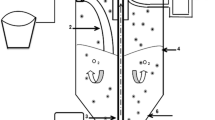Abstract
Various environmental conditions affecting total phosphorus removal from farm wastewater in a biofilm filter, process were investigated using loess balls andChromobacterium LEE-38 at a pilot plant. WhenChromobacterium LEE-38 was used, the removal efficiency of total phosphorous was approximately 10- or 5-fold higher than that ofAcinetobacter CHA-2-14 orAcinetobacter CHA-4-5, respectively. When a loess ball of 11–14 mm manufactured at a 960°C calcining temperature was used, the removal efficiency of total phosphorous was 90.0%. When 70% of the volume fraction was used, the maximum efficiency of total phosphorus removal was 93.1%. Notably, when the initial pH was in the range of 6.0 to 8.0, the maximum removal efficiency of total phosphorus was obtained after 30 days. When the operating temperature was in the range of 30 to 55°C, the maximum removal efficiencies of total phosphorus, 95.6 to 94.6%, were obtained. On the other hand, at operating temperatures below 20°C or above 40°C, the removal efficiency of total phosphorous decreased. Among the various processes, biofilm filter process A gave the highest removal efficiency of 96.4%. Pilot tests of total phosphorus removal using farm wastewater from the biofilm filter process A were carried out for 60 days under optimal condition. WhenAcinetobacters sp. Lee-11 was used, the average removal efficiency in thep-adsorption area was only 32.5%, and the removal efficiencies of chemical oxygen demand (COD) and biological oxygen demand (BOD) were 56.7 and 62.5%, respectively. On the other hand, whenChromobacterium LEE-38 was used, the average removal efficiency was 95.1%, and the removal efficiencies of COD and BOD were 91.3 and 93.2%, respectively.
Similar content being viewed by others
References
Abelson, P. H. (1999) A potential phosphate crisis.Science 283: 2015.
Hammond, A. L. (1971) Phosphate replacements: problems with the washday miracles.Science 172: 361–363.
John, G. C. and T. George (1991)Waster Engineering Treatment. Disposal. and Reuse. 3rd ed., McGraw-Hill, Ino, New York, NY, USA.
Dahab, M. F. (1978) Treatment alternatives for nitrate contaminated groundwater supplies.J. Environ. Sys. 17: 65–71.
Sorg, T. J. (1978) Treatment technology to meet the interim primary drinking water regulation for inorganics.J. Am. Water Works Assoc. 70: 105–109.
Cha, W. S., H. I. Choi, D. B. Lee, and J. M. Cha (2003) Isolation and characterization of denitrification bacteria.Kor. J. Biotechnol. Bioeng. 18: 461–465.
Cha, W. S., K. H. Kwun, H. I. Choi, D. B. Lee, S. H. Kang, and H. S. Kim (2003) A study on phosphorous removal of loess ball.J. Kor. Ind. Eng. Chem. 14: 764–768.
Cha, W. S., H. I. Choi, D. B. Lee, and S. H. Kang (2002) A study on separation and identification of strains for effective removal of T-P and T-N.Theor. Appl. Chem. Eng. 8: 44–49.
Choi, D. B., D. B. Lee, and W. S. Cha (2005) Process development for effective denitrification by biofilter using loess ball.J. Microbiol. Biotechnol. 15: 412–420.
Lee, C. B. (2005)A Study of Advanced Treatment of Wastewater Using Biofilm Filter Process. Ph. D. Thesis. Chosun University, Korea.
DIN (1993) Water quality determination of phosphate (38 405-D11-4) German Standard and Technical Rules, Berlin. e. V. Beuth Verlag, GmbH.
Choi, D. B., K. A. Cho, W. S. Cha, and S. R. Ryu (2004) Effect of triton X-100 on compactin production fromPenicillium citrinum.Biotechnol. Bioprocess Eng. 9: 171–179.
Choi, D. B., C. B. Lee, and W. S. Cha (2005) Optimization for phosphorus remove by loess ball usingChromobacterium.J. Life Sci. 14: 584–589.
Lee, K. Y. and C. G. Lee (2002) Nitrogen removal from wastewater by microalge without consuming organic carbon sources.J. Microbiol. Biotechnol. 12: 979–985.
Oh, Y.-K., Y.-J. Kim, Y. Ahn, S.-K. Song, and S. Park (2004) Color removal of real textile wastewater by sequential anaerobic and aerobic reactors.Biotechnol. Bioprocess. Eng. 9: 419–422.
Thuan, T. H., D.-J. Jahng, J.-Y. Jung, D.-J. Kim, W.-K. Kim, Y.-J. Park, J.-E. Kim, and D.-H. Ahn (2004) Anammox bacteria enrichment in upflow anaerobic sludge blanket (UASB) reactor.Biotechnol. Bioprocess Eng. 9: 345–351.
Author information
Authors and Affiliations
Corresponding author
Additional information
The first two authors contributed equally to this work.
Rights and permissions
About this article
Cite this article
Shin, SE., Choi, D., Lee, CB. et al. Phosphorus removal in pilot plant using biofilm filter process from farm wastewater. Biotechnol. Bioprocess Eng. 11, 325–331 (2006). https://doi.org/10.1007/BF03026248
Received:
Accepted:
Issue Date:
DOI: https://doi.org/10.1007/BF03026248




